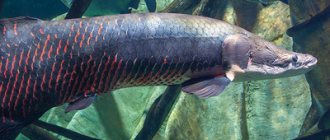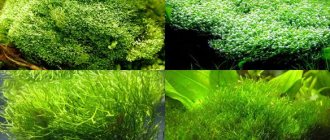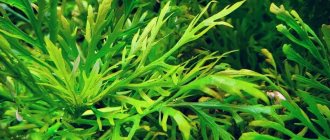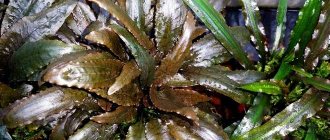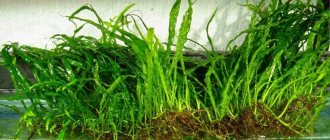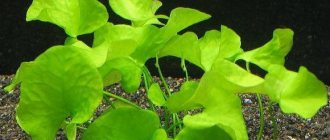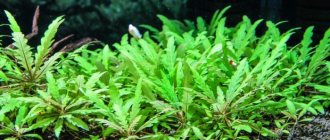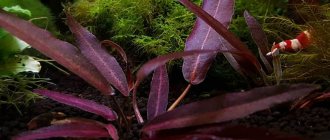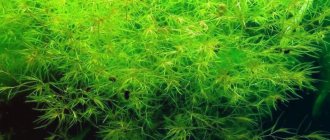Bladderweed is a perennial plant that lives in water. It is absolutely unlike other river and swamp plant inhabitants in its food production method, reproduction methods and other characteristics.
Many famous naturalists, including Darwin, were interested in it. The oldest aquatic plant lives in silted reservoirs all over the world (it is found only in Antarctica and several islands of Oceania), forming dense thickets and feeding on the smallest organisms. This beautifully flowering and decorative algae is a favorite of many aquarists, especially since its carnivorous tendencies are quite manageable.
Botanical description of bladderwort
Bladderweed is a perennial algae with long, branched stems without roots, constantly drifting in the water. They are equipped with numerous pinnately dissected green leaves, up to 5 cm long, which resemble grass. They are notable for their air trap bubbles, which can be either dark or almost transparent, and for their numerous fluffy cilia.
Pemphigus vulgare is a free-drifting algae
Initially, the bubbles were considered floats, allowing the plant not to drown and move freely in the water. But their main role is to provide the nutrition necessary for the full development of algae.
In mid-summer, almost forty-centimeter peduncles with 5-15 bright yellow, two-lipped flowers with reddish stripes appear above the water surface. The dimensions of the upper and lower segments are 1 and 2 cm, respectively. Between them there is sweet nectar that attracts pollinating insects. At the end of flowering, round boxes half a centimeter in size appear with tiny seeds.
Bloom
Proper lighting and stable temperature allows pemphigus to bloom for a long period. The peduncle is a shoot up to 10 centimeters high with a dense rosette: from 4 to 15 flowers. Color ranges from yellow to red-brown. After flowering, bladderwort forms a seed capsule, the diameter of which is about 6 mm.
When setting up an aquarium, keep in mind that the lid will prevent flowering.
Pemphigus vulgare is a predator plant
A herbaceous algae with a meter-long stem has many leaves. Thanks to their unusual structure and rare functions, bladderwort is called a predator plant.
Numerous air bubbles dotting them with a diameter of almost half a centimeter are equipped with a valve that opens inward. It is surrounded by sensitive bristles that instantly respond to the touch of prey by opening the valve. He slams shut with lightning speed with a trophy inside, which is no longer destined to get out: death from suffocation awaits him. The decomposed prey is food for the carnivorous plant.
[adsp-pro-4]
The principle of operation of the mouth valve can be compared to a camera shutter. Due to its small size, it is not dangerous to large aquatic animals. Moreover, the entrance hole is equipped with outgrowths, protrusions and bristles for safety purposes. They protect the structure from large objects.
Potential prey is attracted to the trap by a sweetish mucus bait secreted by special glands. In addition, the valves contrast against the green leaf background with a bright blue color.
Symptoms
Often, the development of pemphigus begins with the mucous membranes (mouth, pharynx). It is very difficult to detect them in a timely manner, because these bubbles burst very quickly. After their accidental opening, only erosions remain, which hurt and have a characteristic bright red color. If treatment is not started, the bubbles grow and merge. At this stage of the disease, the following symptoms are observed:
- foul odor from the mouth;
- decreased appetite due to pain;
- erosions on the oral mucosa.
Bubbles will begin to appear on the epidermis several months after their formation on the oral mucosa. Very rarely, redness of the dermis around the bladder may be observed. It is like a thin rim. Rashes with this pathology are focal in nature. The rash usually appears in the following areas:
- inguinal folds;
- back;
- axillary areas;
- breast.
The opening of the bubbles occurs several days after their occurrence. The resulting erosions are distinguished by their bright pink color, large size, and tendency to merge. The patient begins to worry about the following signs:
- weakness;
- low-grade fever;
- the appearance of purulent discharge on erosions;
- pain;
- cloudiness of the liquid accumulated inside the bubbles;
- pyoderma (it can develop after infection).
Specifics of pemphigus of the oral mucosa
According to medical dental statistics, the oral mucosa is most often affected by pemphigus vulgaris. It is this type of disease that first affects the mucous membrane of the mouth and larynx, and then spreads to the face and body.
- The spread of blisters on the skin may begin several months after the first blisters appear in the mouth, or they may appear immediately, after one or two days.
- With a strong immune system, timely and competent treatment, the spread of blisters over the skin may not begin.
- Erosion that appears on the mucous membrane does not bleed, but due to constant friction and contact with food, it quickly opens.
- In this case, when examining the oral cavity, it is rarely possible to detect the presence of blisters. In place of the blisters, oval or round ulcers remain, which take a long time to heal. As a rule, erosions of the oral mucosa heal without scars.
From the editor: Herbal medicine for fish and aquarium
Oral pemphigus is dangerous due to multiple complications and the addition of additional infections, fungal and viral etiology, which can result from incorrect diagnosis. Further damage to the skin of the body, especially areas with delicate skin (groin, armpits) may occur.
The importance of bladderwort in the aquarium
Bladderwort in the form of a beautiful green garland becomes a real decoration of the aquarium, at the same time enriching the water with oxygen
At first glance, it seems that the predator plant has no place in the aquarium. This is dangerous for small crustaceans and fry. But it has undoubted advantages:
- lush garlands of greenery that simply float on the water;
- with sufficient lighting, beautiful, bright yellow flowers are the best decoration for an aquarium;
- undemanding to care conditions and excellent reproduction abilities;
- saturating the aquarium with oxygen.
What is very important is that the potential danger to aquarium small things that scares away beginners can be easily dealt with and the predatory plant can be “re-educated”. With a sufficient amount of nitrogenous food of animal origin, the trap bubbles of the pemphigus gradually atrophy, and it becomes absolutely safe for its neighbors.
In any case, the bladderwort remains voracious. Reproducing quickly, it needs a lot of food. If the owner of the aquarium begins to save it, then the “unceremonious” plant will take it away from the fish.
Forecast
The prognosis for acantholytic pemphigus is conditionally unfavorable. On the one hand, in the absence of effective treatment, there is a high probability of complications and death.
On the other hand, patients with pemphigus are forced to take glucocorticosteroids for a long time, and sometimes for life, which is fraught with the development of side effects. But hasty refusal of drugs leads to immediate relapse of the disease. Glucocorticosteroids do not eliminate the cause of the disease, but inhibit the pathological process and prevent its progression.
Caring for bladderwort in the aquarium
Predatory algae does not have any special care requirements when growing, so it is accessible even to novice aquarists. It is only intolerant of muddy water, which often leads to the death of the leaves that are constantly in it. Particles of turbidity, settling on them, interfere with their nutrition and breathing. Therefore, an important factor for the comfort of algae is water filtration.
Pemphigus is easy to care for, but does not tolerate cloudy water at all.
The best water indicators for bladderwort:
- temperature from 18 to 24 degrees;
- acidity at neutral level, i.e. with the average value of hydrogen ions present in any acid;
- hardness is also average.
The plant loves bright light, because... sunlight has a beneficial effect on leaf growth. In an aquarium, this effect is created by illumination with a fluorescent lamp.
Preventive measures
There are no specific measures to prevent the development of pathology. The higher the level of immune protection, the less chance of dermatological diseases.
Important:
- control the nature of chronic diseases;
- strengthen immunity;
- maintain personal hygiene;
- Healthy food.
Measures to prevent pemphigus in newborns:
- change your underwear more often;
- Caring for newborns with pustular skin lesions is prohibited;
- Take regular care of your child’s skin;
- strengthen the immune system of weakened children;
- daily wet cleaning and ventilation of the room are required.
If you notice any rashes on the skin, the formation of pustules and blisters, immediately contact a dermatologist.
Methods for propagating bladderwort
There are 2 ways of propagation of carnivorous algae - vegetative and seed. The first method is also called cuttings. It consists of separating a mature branch from the mother stem. It simply floats on the water surface, gradually growing leaves on its own.
The other method is more complicated, but also without human intervention. Unfortunately, it is fully available only in natural conditions. The essence of seed propagation is that a peduncle protruding (like a thin spyglass) from the water, with a bright flower in the shape of the well-known snapdragon, is visible to insects from afar. They fall onto the lower lip of the flower with nectar, while it lowers, completely opening the flower. A complex mechanism is triggered, resulting in an exchange of pollen between the unsuspecting furry guest and the flower, i.e. cross pollination. A seed capsule begins to ripen towards the end of the growing season. The seeds that fall when it opens fall to the bottom of the reservoir and germinate there.
Mechanism of bubble formation
Human skin can be figuratively described as a water-spring “mattress” covered with a kind of “wall”. The “mattress” does not participate in the formation of bubbles - only the top layer, the epidermis, suffers.
The epidermal layer consists of 10-20 cell layers, which look like bricks under a microscope. The “bricks” of the second layer of the epidermis are connected to each other by peculiar “bridges”. On top of the “wall” there are layers of cells that are no longer quite similar to cells, reminiscent of applied cream. These are scales, corneocytes, necessary for protection from mechanical, chemical and physical damage.
If, under the influence of internal or external causes, antibodies are formed that destroy the “bridges” - desmosomes between the cells of the basal layer (this is called acantholysis and can be seen under a microscope), this is true pemphigus. If tissue fluid penetrates between the basal and upper layers of the epidermis without destroying the “bridges,” it is pemphigoid. Viral pemphigus also occurs without destruction of desmosomes.
Problems during cultivation
Pemphigus diseases are caused by insufficiently purified water
The main cause of pemphigus disease is small particles in the water. A filter helps overcome the problem.
Another problem is keeping bladderwort in the aquarium during the winter. At the ends of the stems in the fall, winter buds form in the form of shaggy, green balls of twisted stems. Keeping them in cool water in winter with mandatory lighting, in mid-spring you need to put them on the windowsill of a warm room. Then the buds will quickly grow and eventually turn into full-fledged plants.
[adsp-pro-7]
Symptoms
Considering that experts have identified several different types of this pathology, the symptoms of each of them will be very specific. Of course, there are a number of general trends and signs inherent in all types of the disease. This may include, for example, the wave-like course of the pathological process.
Periods of exacerbation alternate with the transition of pemphigus to a calmer stage, when the main symptoms subside or completely disappear. An important factor for the patient will be the fact that in the absence of timely diagnosis and prescription of an effective course of treatment, there is a high risk of developing severe conditions aggravated by concomitant diseases.
- The presence of crusts, ranging from pale pink soft to red dense, reminiscent of lichen;
- There is a deterioration in the general condition;
- Decreased immune response of the body;
- Formation of bubbles of varying densities;
- Also, in severe cases, separation of the layers of the epidermis is noted, and it can occur both in the lesion and away from it.
- Damage and ulcers of the mucous membrane of the mouth, nasopharynx or genitals;
- Pain when performing the act of swallowing or when eating;
- Bad breath, indicating damage to the mucous membranes;
- Hypersalivation or, in other words, increased salivation;
- In the seborrheic form, characteristic yellowish or brown-brown crusts appear on the scalp.
- Bubbles vary in appearance, ranging from flat to thin-walled, which burst with a slight touch. In their place, erosions and, subsequently, crusts form.
- In severe cases, an eroded surface of the skin may form in place of the blisters. Their feature is a tendency towards peripheral growth. Over time, such erosions occupy a large surface of the skin, causing pain and inconvenience to the patient.
- In children, manifestations of pemphigus are localized over the entire surface of the skin, including the limbs.
Experts say that with this disease, both a pure form of the pathological process and mixed forms that smoothly transform into one another can be observed. Therefore, the symptoms and signs of pemphigus in a given person may vary and indicate the presence of several types of disease.
Interesting facts about the carnivorous bladderwort
Pemphigus vulgare is a real plant predator
It is impossible to convey all the interesting information about this unusual plant. Here are just a few facts indicating this phenomenon:
- In terms of reaction speed in capturing the trophy - 5 milliseconds - she left behind the Venus flytrap.
- The walls of its vesicles are equipped with glands similar to the same organs of the sundew. But unlike sundews, these structures do not secrete digestive juices to digest victims, but rather absorb juices from suffocated and decomposed corpses.
- Without animal proteins, algae grow twice as slow.
- In a few hours, a fifteen-centimeter plant with one and a half dozen leaves can absorb 270 crustaceans.
- Tiny fry of bladderwort can be simultaneously held by the head and tail using various bubbles.
- Experiments have proven that Darwin was wrong in classifying bladderworts as vultures. In fact, the plant actively hunts for victims, rather than picking up their corpses. His behavior is exactly that of a predator.
Young algae are no different in behavior from ordinary plants. They become aggressive only with the appearance of bubbles.
Why isn't it growing?
This is a seasonal plant characterized by rapid growth. The carnivorous plant is not susceptible to disease and, under unfavorable conditions, can switch to an alternative method of nutrition. No problems with growth were noted by experienced aquarists.
Bladderwort is usually found in large ponds or lakes. It is very adaptable and can be grown in both temperate and tropical conditions. This unusual plant will decorate any aquarium.
Treatment
The process of successful treatment of pemphigus is quite complex even in a modern medical center. Self-medication is absolutely unacceptable here and can even lead to death. Those suffering from the consequences of pemphigus, even in its mildest, seborrheic form, must undergo medical observation by a dermatologist.
From the editor: External filter for an aquarium, which is better?
Patients are prescribed a calm regimen without active physical activity, a complete elimination of stress, sleep that is clearly limited by hours, and contact with salt water on the skin is strictly contraindicated (swimming in the sea will have to be avoided). All patients, regardless of the type of disease, are required to follow a hypoallergenic diet: that is, completely exclude hard foods, canned food, pickles, sweets and extractive substances from consumption.
If the oral mucosa is affected, it is recommended to consume protein-rich pureed foods (thick meat sauces, baby food). They accelerate the overall regeneration of the body and promote the healing of open erosions.
In order to avoid secondary infection, patients are recommended to constantly change their bed linen.
Patients are prescribed high dosages of cytostatics and glucocorticosteroids (as open manifestations of the disease heal, the dosage level is reduced), potassium, calcium and ascorbic acid. When the crisis is over, the doctor, ignoring contraindications, may prescribe Prednisolone orally and Betamethasone for external use.
When treating all types of pemphigus, methods of treating blood outside the patient’s body are used, they are called extracorporeal hemocorrection. And this:
- membrane plasmapheresis;
- hemosorption;
- cryoapheresis;
- other methods.
Neutral antiseptic solutions and traditional aniline dyes can be used as accompanying preparations.
Bladderwort in garden landscape design (with photo)
An unpretentious, but very pretty plant attracts the attention of collectors and gardeners. The bladderwort in landscape design looks impressive, catchy, and profitable
A bladderwrack bush of any variety will add zest to your garden - look at the photo to see how interesting improvisations can be:
If you plant two varieties of this plant next to each other, they will “play” very organically, shading each other. It is necessary to study the characteristics of different species, including the properties of seasonal changes in leaf color. If you choose the right varieties, the appearance of the site will be transformed beyond recognition.
Bladderwort is excellent for forming a natural fence, as it tolerates frequent pruning without pain. Hedges can be easily shaped into almost any shape you like. It is worth remembering that the plant is massive, so dwarf forms are more suitable for small areas. The shrub combines harmoniously with other representatives of the flora.
Take a look at the photo - the bladderwort in the garden landscape design looks very original:
Beautiful plantings delight the eye and awaken bright and kind feelings in the soul. Bladderwort is an option that successfully performs aesthetic functions and gives the areas a special charm. He gratefully responds to the slightest concern and does not cause any trouble to his owners.
